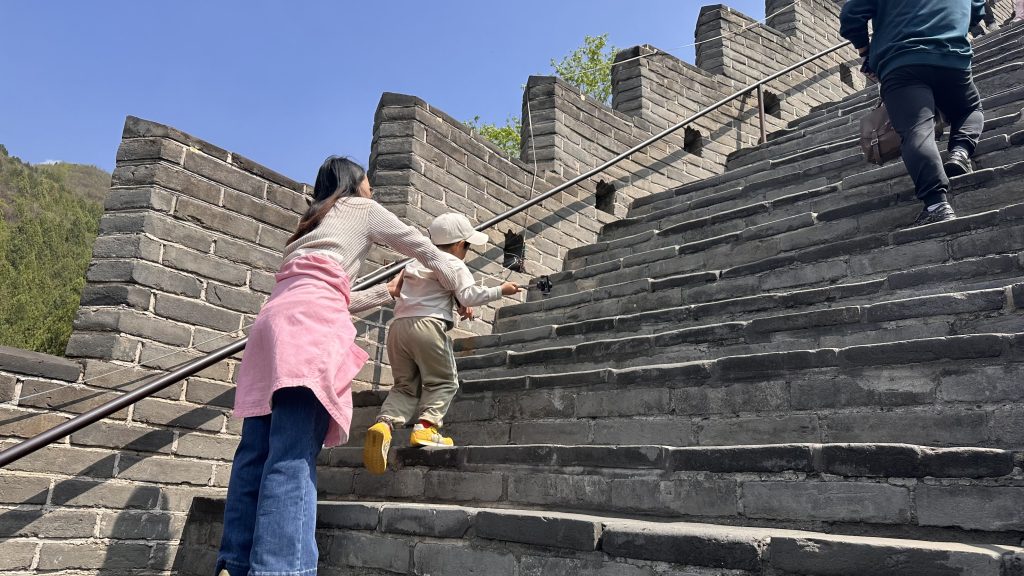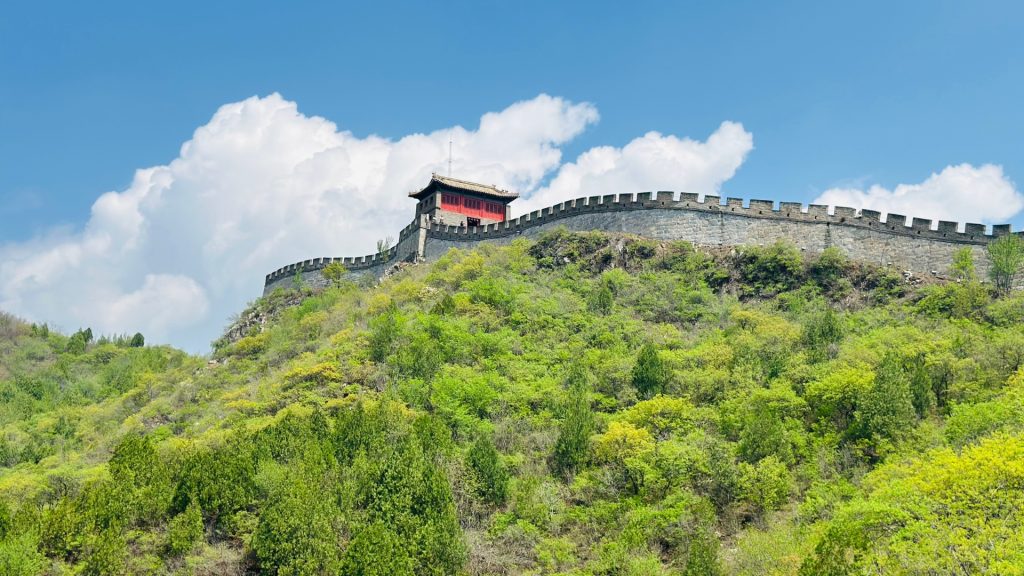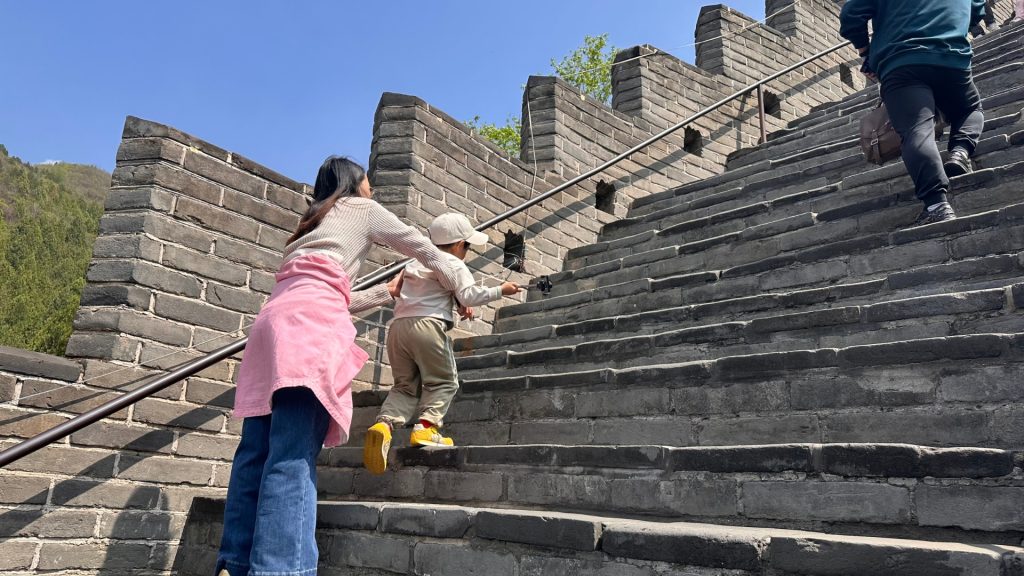By James Amoh Junior, GNA Special Correspondent in Beijin, China
Beijing, April 23, GNA – The majestic Great Wall of China, is a serpent of stone and history winding through rugged mountains into the horizon.
This ancient marvel, often romanticized in books and films, is even more breathtaking when seen in person.
As feets touched the weathered bricks of the Badaling section of the Great Wall, the sheer scale of this 2,300-year-old fortress strikes with awe.
No wonder It is considered one of the new Seven Wonders of the World.
Stretching over 21,000 kilometers — a distance that could cross Ghana several times — the Wall is not just a barrier but a living chronicle of China’s imperial past.
History
The Great Wall of China, one of the most remarkable architectural feats in history, was built over two millennia as a defense against invasions and raids.
Its earliest sections date back to the 7th century BCE, when the state of Chu constructed a fortified barrier.
Over time, rival states built their own walls, which were later connected by China’s first emperor, Qin Shihuang, in the 3rd century BCE. This unified structure, stretching thousands of miles, became known as the “10,000-Li Long Wall.”
During the Ming Dynasty (1368–1644), the Wall reached its most formidable form, extending approximately 5,500 miles across northern China.
Built with stone, brick, and rammed earth, it featured watchtowers, garrison stations, and strategic passes.

Despite its military purpose, the Wall also facilitated trade and control along the Silk Road.
After the Ming era, the Wall fell into disrepair under the Qing Dynasty, as China’s rulers pursued diplomacy over fortification.
Mu Chen Yao, a tour guide, and a graduate of the Chinese Culture University in Beijing, says, while some sections lie in ruins, restored portions — like those at Badaling and Mutianyu — stand as enduring symbols of China’s historical resilience.
He confirms that the Great Wall, an extensive bulwark erected in ancient China, is one of the largest building-construction projects ever undertaken in human history.
Recognized as a UNESCO World Heritage Site in 1987, Mr Chen says the Great Wall remains a testament to human ingenuity and perseverance.
A walk through time
The Great Wall consists of numerous walls — many of them parallel to each other — built over some two millennia across northern China and southern Mongolia.
The most extensive and best-preserved version of the wall dates from the Ming dynasty (1368–1644) and runs for some 5,500 miles (8,850 km) east to west from Mount Hu near Dandong, southeastern Liaoning province, to Jiayu Pass west of Jiuquan, northwestern Gansu province.
This wall often traces the crestlines of hills and mountains as it snakes across the Chinese countryside, and about one-fourth of its length consists solely of natural barriers such as rivers and mountain ridges.
Nearly all of the rest (about 70 per cent of the total length) is actual constructed wall, with the small remaining stretches constituting ditches or moats.
Climbing the steep, uneven steps, one would marvel at the watchtowers that once housed soldiers scanning the depths for Mongol raiders.

The Ming Dynasty builders who reinforced these sections never imagined their creation would one day host 10 million visitors a year, from backpackers to presidents.
Yasmin Mufeed Alnueirat, Director of Public Relations and Marketing, Bahrain Inherited Traditional Sport committee, who could not hide her excitement about the long walk said, “Visiting the Great Wall of China was a truly unforgettable experience for me. Standing atop one of the world’s greatest wonders in the heart of Beijing, China, filled me with awe and pride.
To make the moment even more meaningful, Ms Yasmin brought a taste of Bahrain (Showeeter – Bahraini Confectionery) with her for her colleagues on the visit.
That for her was a small but heartfelt cultural exchange, and that “The joy and curiosity on their faces reminded me of how powerful even the simplest gestures can be in building bridges between people. This small act of sharing sweets became a symbol of Bahrain’s warmth and generosity.”

Ms Yasmin, also Producer and Presenter at Bahrain’s Minstry of Information Affairs, further states that, “the moment did not only introduced our culture to an international audience but also reflected the deep-rooted friendship and mutual respect between Bahrain and China which highlight the strong historical and social ties our nations share.”
A South Sudanese tourist, Odolla Owar Odolla, who attempted to help a colleague navigate a particularly steep section retorted, “Even we find it tough! But imagine carrying bricks up these mountains centuries ago — no machines, just muscle and will.”
His first time in China, Mr Odolla notes that in all his adventures, “this has been the most exiting and he will keep all the memories with him for a long time.”
Ms Malebo Thapelo Mfopa, a South African Journalist, who embarked on the long walk of the Great Wall, says she has been looking forward to an experience like that from childhood, having watched the popular 90s movie “The Karate Kid”.
“In the beginning I was frightened but when I began what was going to be an exciting journey of a lifetime, I was encouraged by the little children and old men who defied their seeming weakness to climb all the way.”
For her, it was an adventure she had yearned to undertake but was bucked up by some rather enthusiastic colleagues, albeit their impuissance from the get go.



“It was fascinating but also a moment to make all the great memories, taking photos with friends and new acquaintances alike. We finally made it to the top. I had an absolutely great experience.” Ms Thapela adds.
For Ms Rhoda Grace Saron, a Reporter of the Mindanao Times in Davao Philippines, “It is surreal to walk through the Forbidden City, a place that once existed only in my high school history books, filled with tales of dynasties, power, and rich culture.
To now witness its immense reality – a 72 hectare expanse with over 9,000 rooms, she adds “It is truly humbling.”
Just like Thapelo, Ms Saron admits that, “Yes, my feet are aching, but the grandeur of this historical piece makes every step worthwhile.”
Mia Du Yue and Jackie Lu Jiaqi, Seminar Assistants from the Academy of International Business Officials (AIBO), explaining the reason for choosing the Great Wall of China as one of the sites of interest, said “any body who hopes to visit China has that on their list.”
“The Great Wall is the work of human wisdom.” Ms Jackie states as Ms Mia adds that, “It is very historic to the Chinese people and gives a deep impression about the ingenuity of the Chinese people.”
Ednal Palmer, journalist from Solmon Islands shares: “Since my school days, I’ve been captivated by images and stories of the Great Wall, and visiting it became one of my lifelong dreams,”
“The Great Wall offers more than just historical wonders – it’s a naturally therapeutic experience and fantastic exercise,” observes Nutshidzi Oudrey Rambau, South African journalist.
Design and fortifications
The Great Wall of China was not just a simple barrier but a sophisticated defensive system designed for maximum protection.
Its fortifications included three key elements: passes, signal towers, and the wall itself. The passes served as heavily guarded strongholds at strategic points, often located near trade routes or vulnerable crossings.
These were built with massive brick and stone ramparts, standing about 30 feet high, and featured double wooden gates reinforced with bolts and locking rings.
Above each gate rose a watchtower, used for surveillance and command, while semicircular outer walls called “wengcheng” provided additional defense against direct assaults.
Some passes even had moats dug around their entrances, adding another layer of security.
Signal towers, perched on high ground for visibility, were crucial for military communication. They used smoke by day and fire by night to relay messages across vast distances, with additional methods like flag signals or gunfire for urgent alerts.
These towers also functioned as self-contained garrisons, with storage rooms, stables, and living quarters for soldiers.
Some sections of the wall varied in construction techniques, depending on the terrain, blending rammed earth, stone, and brick. On average, it stood 23 to 26 feet tall, with a base width of 21 feet tapering slightly at the top. Steep sections followed natural ridges, while flatlands required sturdy man-made barriers.

The walkway along the top was lined with crenellated parapets for archers, and guard towers jutted out at regular intervals, allowing defenders to attack invaders from multiple angles.
Every detail of the Great Wall’s design reflected its dual purpose: to repel invaders and control movement.
The passes regulated trade and troop movements, the signal towers ensured rapid communication, and the wall’s imposing structure deterred attacks.
Even in ruins, the engineering brilliance of this ancient megastructure continues to awe visitors today.
The engineering marvel
The Great Wall’s imposing structure formed the backbone of China’s ancient defensive system, meticulously designed to withstand both invaders and the natural elements.
Stretching across diverse landscapes, its construction varied based on terrain and available materials. In the western deserts, builders used compacted earth and sun-dried mud bricks, creating sturdy but simpler barriers.
In contrast, eastern sections like Badaling showcase the wall’s most advanced engineering—faced with stone and reinforced with intricate features.

The wall typically measured 21 feet wide at its base, narrowing slightly to 19 feet at the top, with heights averaging 23 to 26 feet — though builders adjusted dimensions on steep slopes to blend with natural defenses.
Clever architectural details reveal the wall’s strategic brilliance. Small arched doorways called “juan”, built into the inner walls at regular intervals, allowed soldiers to access the battlements via hidden staircases.
Every 650 to 1,000 feet, elevated platforms jutted outward, enabling flank attacks on enemies scaling the walls. These platforms also housed simple shelters (pufang) for guards during storms, while multi-story versions served as armories and barracks—some accommodating over a dozen soldiers.
Even rainwater was managed with precision; carefully placed drainage channels prevented erosion, ensuring the wall’s longevity.
Conclusion
More than just a barrier, the Great Wall was a dynamic fortress. Its design harmonized with nature, using cliffs and rivers where possible, while man-made segments incorporated lethal ingenuity.
From the materials underfoot to the towers overhead, every element served a purpose — turning stone and earth into an unconquerable symbol of resilience.
Today, these very features whisper tales of the countless soldiers who once stood watch atop this wonder of the ancient world.
GNA
SOF
